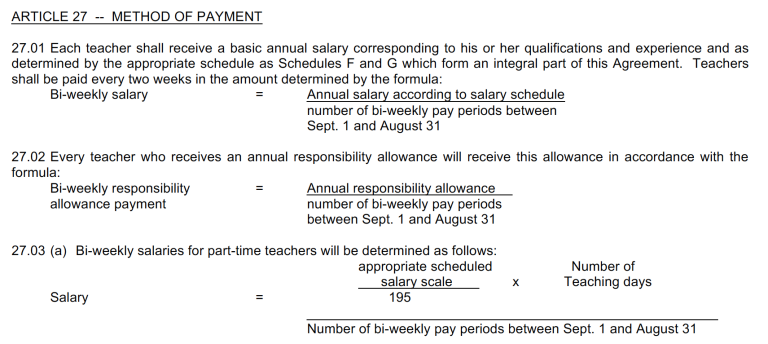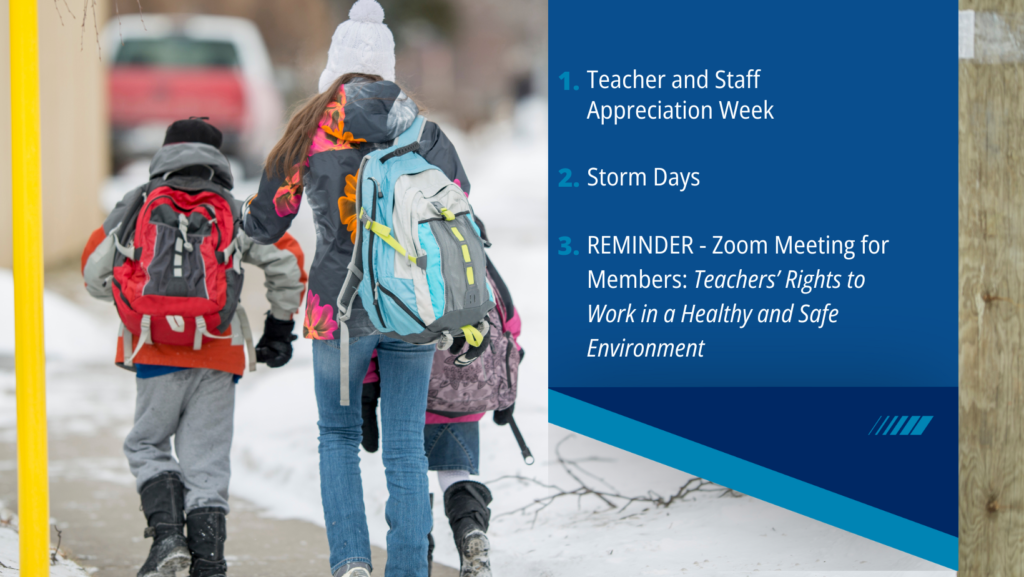
Understanding your Paystub
Collective Agreement – Article 27
“Each teacher [under contract] shall receive a basic annual salary corresponding to his or her qualifications and experience and as determined by the appropriate schedule as Schedule F and G which form an integral part of this [Collective] Agreement.”
Here is an example of Schedule G:

- Teachers are paid for 195 teaching days per school year.
- Note: All days of the week that are not legal holidays or vacation days are considered teaching days. Please refer to Article 16 of the Collective Agreement for further information regarding the length of the school year.
- Teachers earn one year of experience after every 195 days of teaching (substitute or contract days).
- Certified teachers working under contract start at level 1 of the grid and go up one level after every 195 days of work.
- Article 27 of the collective agreement sets out the formula used to determine the amount of pay each teacher will receive every two weeks.

- A simple way for a teacher to verify if they are being paid the correct salary, is to take their gross income indicated on their pay stub (Earnings code 01) and multiply that amount by 26 (number of pay periods per school year). This amount should be equal to the salary corresponding to the grid.
- Example: if a teacher has 5 years of teaching experience and has a certificate 5, their base salary is $64,945. If we divide this number by 26 = $2,497.89 is his gross income.
*Note: When a teacher takes a leave without pay, the amount deducted for each day is 195/yearly salary. With the example given above, this teacher would be deducted $333.06 for each day of unpaid leave ($64 945/195).
- Teachers should see on their pay stubs the deductions for the following:
- Canada Pension Plan (CPP) – deduction code 01
- Pension – deduction code 02
- Employment Insurance (EI) – deduction code 03
- Federal Income Tax – deduction code 04
- Union dues – deduction code 17 (union dues are not deducted in July and August)
- Teachers’ Group Insurance (Johnson) – deduction code 18.
* If a teacher does not see these deductions on their pay stub, the NBTF strongly recommends that they contact their school district payroll department immediately to see if there are any discrepancies that need to be corrected.
* Teachers may have additional deductions for personal reasons.
Additional Information:
- If you are a supply teacher, please refer to Schedule M of the Collective Agreement to find your daily rate of pay.
- If you are a teacher with a D contract that is not for a full school year, your pay will be calculated differently depending on when your D contract starts and ends. Please contact the NBTF for more information.
- Once in about every 11 years, there will be 27 pay periods in one school year and that will affect the amount of each pay as the total salary will be divided by 27 instead of 26. The last time this happened was in the 2017-2018 school year.
- Section 18(2) of the Employment Standards Act states: ” Subject to subsections (3), (4) and (5), an employer shall give to an employee a holiday on each public holiday and pay to the employee his regular wages for each public holiday.” The requirements of the Act are therefore to grant leave and pay regular wages.In addition, Section 23 of the same Act states, ” Where any class of employers or employees is covered by a collective agreement that became effective after July 16, 1976 and provides for a minimum of eight paid holidays, including New Brunswick Day, that class of employers and employees are exempt from the application of sections 18 to 21.”Since the teacher had the day off and there is no reduction in the teacher’s pay on a statutory holiday, it can be concluded that the teacher is paid for the statutory holidays at his normal rate of pay and the Act would not apply.
If you have any questions on this matter, please contact the NBTF Labour Relations Officer assigned to your district at 1-888-679-7044.
Replacement of Absent Teachers
As school districts continue to struggle to find supply teachers, the NBTF has received numerous inquiries in regards to Article 21. The most common question asked by teachers is:
“ If a supply teacher cannot be found by the beginning of classes, can I be asked to cover a class? ”
The answer is yes, you can be asked. However, whether you accept or refuse to do so is left solely to your discretion, unless it is an emergency situation.
Article 21 of the Collective Agreement is clear:
21.01 The Employer will make a reasonable effort to hire certified supply teachers to replace absent teachers.
21.02 A teacher may agree or may refuse to replace an absent teacher.
21.03 Notwithstanding Clause 21.02, if, during the hours of instruction, an emergency arises, which would result in a class being unattended by a teacher, the Employer may require a teacher to replace the absent teacher until the arrival of a supply teacher. If a teacher is required to replace an absent teacher pursuant to this clause, the teacher must be informed as soon as practicable of the circumstances justifying such requirement.
Not being able to find a supply teacher is not considered an emergency. If a teacher has to leave suddenly during the school day, that would be considered an emergency and a teacher may be asked to cover until someone else can be found to come in.
Another popular question is:
“ Can I be recalled from district PL because a supply teacher could not be found?”
Yes, you could be required to return to your school in order to do your usual workload.
School principals should inform the district when they are not able to secure a supply teacher.
CLICK HERE for more information on lesson plans for Supply Teachers
For other questions related to this subject, please contact a NBTF staff officer at 1-888-679-7044.
Carry Over of Family Responsibility Day
The NBTF would like to remind their members that an agreement was reached with the Department of EECD to allow all teachers under B contract to carry over their “Family Responsibility Day” from the 2021-2022 school year to the 2022-2023 school year.
Guidelines:
- This leave is for the use of all schedule “B” full-time teachers (1.0 FTE).
- Teachers who are on a deferred leave or preretirement leave can access this as long as they are a 1.0 FTE B teacher.
- Teachers are entitled to one full day or two half days per year.
- Leave under this article does not accumulate if not used during a particular school year.
Note: Exception was granted for the 2021-2022 school year.
- Teachers are not permitted to take this leave on days where Professional Development has been planned or Parent Teacher Interviews have been scheduled.
- Leave under this article is not to be used to extend a vacation or holiday period; however, it can be used following a leave with or without pay. Leave without pay remains at the discretion of the employer.
Note: To clarify, a Family Responsibility Leave can be requested on a Monday or on a Friday if it does not extend a long weekend.
- Whenever possible, teachers should provide at least three days’ notice when requesting this leave.
- The employer will exercise discretion in deciding who is approved if a number of teachers in the same school request the same day.
If you have any questions or concerns regarding the use of your “Family Responsibility Day“, please contact the NBTF at 1 888 679-7044 or by email at nbtf-fenb@nbtffenb.ca.
NBTF Contacts
Every day, the NBTF staff offers sound advice to members who have questions about their working conditions or benefits.
* All calls or emails are confidential.
Are you a school administrator or do you have a question about Policy 701?
Caroline Foisy – Deputy Executive Director
caroline.foisy@nbtffenb.ca
506 452-1763
Are you a teacher in ASD-S, ASD-N or ASD-W?
Barry Snider – Labour Relations Officer
barry.snider@nbtffenb.ca
506 452-1762
Are you a teacher in DSF-NE, DSF-NO, DSF-S or ASD-E?
Nicole LeBlanc – Labour Relations Officer
nicole.leblanc@nbtffenb.ca
506 452-1768
For general inquiries, please contact the NBTF at nbtf-fenb@nbtffenb.ca or 1 888 679-7044.



